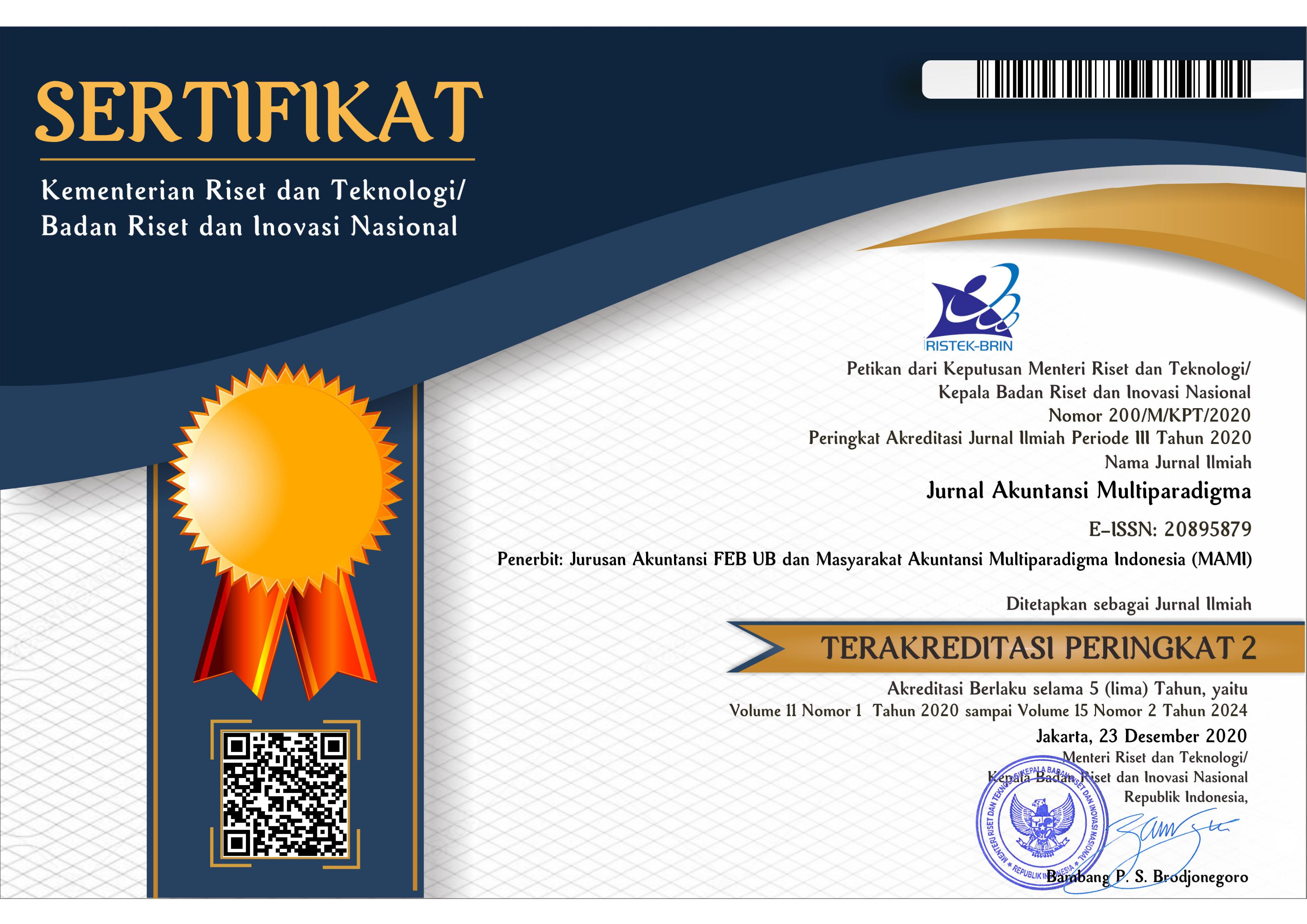FALSAFAH KESENIAN TANJIDOR PADA PELAKSANAAN CORPORATE SOCIAL RESPONSIBILITY
Abstract
Abstrak: Falsafah Kesenian Tanjidor pada Pelaksanaan Corporate Social Responsibility. Artikel ini bertujuan untuk mengetahui bagaimana Corporate Social Responsibility (CSR), dengan berlandaskan falsafah kesenian tanjidor, dapat meningkatkan kinerja perusahaan. Metode yang digunakan adalah studi literatur dari berbagai sumber. Artikel ini mendapati titik balik antara falsafah kesenian tanjidor dengan konsep triple bottom line sebagai dasar CSR. Hal ini terwujud dalam pelaksanaan kegiatan bisnis, yang harus lebih mengutamakan integritas antara tujuan dan kewajiban. Selain itu, perusahaan seharusnya melaksanakan CSR tidak sekedar memuaskan diri sendiri, tetapi juga menghibur dan menyenangkan hati masyarakat sekitar.
Abstract: Tanjidor Art Philosophy on the Implementation of Corporate Social Responsibility. This article aims to find out how Corporate Social Responsibility (CSR), based on tanjidor art philosophy, can improve company performance. The method used is the study of literature from various sources. This article finds the turning point between the philosophy of tanjidor art and triple bottom line concept as the basis for CSR. This is manifested in the implementation of business activities, which must prioritize integrity between goals and obligations. In addition, companies should carry out CSR not only to satisfy themselves, but also to entertain and delight the surrounding community.
Keywords
Full Text:
PDFReferences
Albareda, L., & Waddock, S. (2018). Networked CSR Governance: A Whole Network Approach to Meta-Governance. Business & Society, 57(4), 636–675. https://doi.org/10.1177/0007650315624205
Brown-Liburd, H., & Zamora, V. L. (2015). The Role of Corporate Social Responsibility (CSR) Assurance in Investors' Judgments When Managerial Pay is Explicitly Tied to CSR Performance. AUDITING: A Journal of Practice & Theory, 34(1), 75-96. https://doi.org/10.2308/ajpt-50813
Casey, R. J., Grenier, J. H. (2015). Understanding and Contributing to the Enigma of Corporate Social Responsibility (CSR) Assurance in the United States. AUDITING: A Journal of Practice & Theory, 34(1), 97-130. https://doi.org/10.2308/ajpt-50736
Chaudhri, V. (2016). Corporate Social Responsibility and the Communication Imperative: Perspectives from CSR Managers. International Journal of Business Communication, 53(4), 419–442. https://doi.org/10.1177/2329488414525469
Darwis, N. R. M. (2012). Perspektif Nilai Budaya Masyarakat Bugis dalam Penerapan Corporate Social Responsibilty pada PT.Taspi Trending Coy Makassar (PO PIPPOS). Universitas Hasanuddin.
Fauzi, A. S., Suransi, N. K., & Alamsyah. (2016). Pengaruh GCG dan CSR terhadap Nilai Perusahaan dengan Profitabilitas sebagai Variabel Moderasi. InFestasi, 12(1), 1-19. https://doi.org/10.21107/infestasi.v12i1.1797
Faizah, N., Zid, M., & Hardi, O. S. (2018). Mobilitas Sosial dan Identitas Etnis Betawi (Studi terhadap Perubahan Fungsi dan Pola Persebaran Kesenian Ondel-Ondel di DKI Jakarta). Jurnal Spatial: Wahana Komunikasi dan Informasi Geografi, 18(1), 36-50.
Hinson, R. E., & Ndhlovu, T. P. (2011). Conceptualising Corporate Social Responsibility (CSR) and Corporate Social Investment (CSI): The South African Context. Social Responsibility Journal, 7(3), 332–346. https://doi.org/10.1108/17471111111154491
Jamali, D., & Sdiani, Y. (2013). Does Religiosity Determine Affinities to CSR? Journal of Management, Spirituality & Religion, 10(4), 309-323. https://doi.org/10.1080/14766086.2013.802251
Johansen, T. S., & Nielsen, A. E. (2012). CSR in Corporate Self‐Storying – Legitimacy as a Question of Differentiation and Conformity. Corporate Communications: An International Journal, 17(4), 434-448. https://doi.org/10.1108/13563281211274130
Kovács, G. (2015). Soulful Corporations – A Values-Based Perspective on Corporate Social Responsibility. Journal of Management, Spirituality & Religion, 12(2), 178-181. https://doi.org/10.1080/14766086.2014.992357
Lim, J. S., & Greenwood, C. A. (2017). Communicating Corporate Social Responsibility (CSR): Stakeholder Responsiveness and Engagement Strategy to Achieve CSR Goals. Public Relations Review, 43(4), 768-776. https://doi.org/10.1016/j.pubrev.2017.06.007
Lindawati, A. S. L., & Puspita, M. E. (2015). Corporate Social Responsibility: Implikasi Stakeholder dan Legitimacy Gap dalam Peningkatan Kinerja Perusahaan. Jurnal Akuntansi Multiparadigma, 6(1), 157–174. https://doi.org/10.18202/jamal.2015.04.6013
Looser, S., & Wehrmeyer, W. (2015) Stakeholder Mapping of CSR in Switzerland. Social Responsibility Journal, 11(4), 780-830. https://doi.org/10.1108/SRJ-06-2014-0071
Mandaika, Y., & Salim, H. (2015). Pengaruh Ukuran Perusahaan, Kinerja Keuangan, Tipe Industri, dan Financial Leverage terhadap Pengungkapan Corporate Social Responsibility: Studi Empiris pada Perusahaan Manufaktur yang Terdaftar di Bursa Efek Indonesia Tahun 2011--2013.Jurnal Akuntansi, 8(2), 181-201. https://doi.org/10.25170/JRAK.V8I2.395
Mapisangka, A. (2009). Implementasi CSR terhadap Kesejahteraan Hidup Masyarakat. Jurnal Ekonomi dan Studi Pembangunan, 1(1), 39-47.
Margaretha, F. & Witedjo, C. G. (2014). CSR, Nilai Perusahaan dan Kinerja Keuangan Perusahaan pada Industri Pertambangan dan Manufaktur di Indonesia. Media Riset Akuntansi, Auditing Dan Informasi, 14(1), 89–114. https://doi.org/10.25105/mraai.v14i1.1754
Megawanti, P. (2015). Persepsi Masyarakat Setu Babakan terhadap Perkampungan Budaya Betawi dalam Upaya Melestarikan Kebudayaan Betawi. Sosio E-Kons, 7(3), 226-238.
Nur, M., & Priantinah, D. (2012). Analisis Faktor-Faktor yang Mempengaruhi Pengungkapan Corporate Social Responsibility di Indonesia (Studi Empiris pada Perusahaan Berkategori High Profile yang Listing di Bursa Efek Indonesia). Nominal: Barometer Riset Akuntansi dan Manajemen, 1(2), 22-34. http://doi.org/10.21831/nominal.v1i2.996
Oktaviani, R. M. (2012). Fenomenologi: Corporate Social Responsibility dan Strategi Perusahaan HOLCIM dalam Corporate Sustainable Development Report 2008-2009. Jurnal Bisnis dan Ekonomi, 19(1), 84-92.
Park, B, I., & Ghauri, P. N. (2015). Determinants Influencing CSR Practices in Small and Medium Sized MNE Subsidiaries: A Stakeholder Perspective. Journal of World Business, 50(1), 192-204. https://doi.org/10.1016/j.jwb.2014.04.007
Pertiwi, I. D. A. E., & Ludigdo, U. (2013). Implementasi Corporate Social Responsibility Berlandaskan Budaya Tri Hita Karana. Jurnal Akuntansi Multiparadigma, 4(3), 433-455. http://dx.doi.org/10.18202/jamal.2013.12.7208
Purnama, Y, (2015). Peranan Sanggar dalam Melestarikan Kesenian Tradisional Betawi. Patanjala: Jurnal Penelitian Sejarah dan Budaya, 7(3), 461-476. http://dx.doi.org/10.30959/patanjala.v7i3.112
Retno, R. D., & Priantinah, D. (2012). Pengaruh Good Corporate Governance dan Pengungkapan Corporate Social Responsibility terhadap Nilai Perusahaan (Studi Empiris pada Perusahaan yang Terdaftar di BEI Periode 2007-2009). Nominal: Barometer Riset Akuntansi dan Manajemen, 1(2), 84-93. https://doi.org/10.21831/nominal.v1i2.1000
Rettab, B., Brik, A. B., & Mellahi, K. (2009). A Study of Management Perceptions of the Impact of Corporate Social Responsibility on Organisational Performance in Emerging Economies: The Case of Dubai. Journal of Business Ethics, 89(3), 371–390. https://doi.org/10.1007/s10551-008-0005-9
Reverte, C. (2009). Determinants of Corporate Social Responsibility Disclosure Ratings by Spanish Listed Firms. Journal of Business Ethics, 88(2), 351–366. https://doi.org/10.1007/s10551-008-9968-9
Risa, N., Sulastri, T., & Pramono, J. (2011). Corporate Social Responsibility Perusahaan kepada Masyarakat Studi Kasus pada PT. Gold Coin Specialities. Jurnal Riset Akuntansi & Komputerisasi Akuntansi, 2(2), 73-83.
Schmeltz, L. (2017). Getting CSR Communication Fit: A Study of Strategically Fitting Cause, Consumers and Company in Corporate CSR Communication. Public Relations Inquiry, 6(1), 47–72. https://doi.org/10.1177/2046147X16666731
Shahab, Y. Z. (2001). Rekacipta Tradisi Betawi: Sisi Otoritas dalam Proses Nasionalisasi Tradisi Lokal. Antropologi Indonesia, 66, 46-57. https://doi/org/10.7454/ai.v0i66.3422
Suchman, M. C. (1995). Managing Legitimacy: Strategic and Institutional Approaches. The Academy of Management Review, 20(3), 571-610. https://doi.org/10.2307/258788
Suryani, I., & Sagiyanto, A. (2017). Strategi Komunitas Betawi dalam Mempromosikan Tradisi Palang Pintu (Studi Kasus pada Event Festival Palang Pintu XI). Jurnal Komunikasi, 8(2), 1-7. https://doi.org/10.31294/jkom.v8i2.2497
Tarwiyah, T. (2010). Pelestarian Budaya Betawi Permainan Anak Cici Putri dan Ulabang/ Wak Wak Gung: Kajian Kandungan Kecerdasan Jamak. Harmonia: Journal of Arts Research and Education, 10(1), 1-17. https://doi.org/10.15294/harmonia.v10i1.51
Verma, P., & Singh, A. (2016). Fostering Stakeholders Trust through CSR Reporting: An Analytical Focus. IIM Kozhikode Society & Management Review, 5(2), 186–199. https://doi.org/10.1177/2277975215618473
Wardiningsih, S. (2014). Lanskap Budaya Wisata Budaya Betawi (Studi kasus Kota Tua Jakarta Kota). Jurnal Arsitektur Nalars, 13(2), 117-122. https://doi.org/10.24853/nalars.13.2.%25p
Windarsih, A. (2013). Memahami “Betawi” dalam Konteks Cagar Budaya Condet dan Setu Babakan. Jurnal Masyarakat dan Budaya, 15(1), 177-200. https://doi.org/10.14203/jmb.v15i1.146
Zahller, K. A., Arnold, V., & Roberts, R. W. (2015). Using CSR Disclosure Quality to Develop Social Resilience to Exogenous Shocks: A Test of Investor Perceptions. Behavioral Research in Accounting, 27(2), 155-177. https://doi.org/10.2308/bria-51118
DOI: http://dx.doi.org/10.18202/jamal.2018.04.9023
Refbacks
- There are currently no refbacks.
Copyright (c) 2018 Manikam Apriliani, M Wahyudin Abdullah

This work is licensed under a Creative Commons Attribution-NonCommercial 4.0 International License.

















